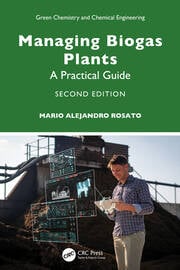Sustainable Technologies has published a case study about the application of the AMPTS technology in the World Biogas Technology Guide 2026, published by the WBA.
Click on the link to read online and download the guide for free.
Sustainable Technologies has published a case study about the application of the AMPTS technology in the World Biogas Technology Guide 2026, published by the WBA.
Click on the link to read online and download the guide for free.
Sustainable Technologies collaborated in the redaction of the captioned document, in both the topics about bamboo for the production of wind turbine blades and new materials for thermoacoustic motor development.
More details in the blog entry , where the full document can be downloaded for free.
Sustainable Technologies is partner of the research consortium H2Ocean. Our role will consist in the research of the possibility to produce biohydrogen or biogas through an anaerobic fermentation process in a multifunctional offshore platform to be developed by the other partners of the consortium. The project is financed by the 7th Frame Program of the European Comission.
For more information, please visit the official website of the Consortium
The problem:
With the diffusion of the plasma and LCD screens, the old cathodic ray tube (CRT) is slowly disappearing. Milions of TV sets and monitors will have to be recycled. The CRT is made of glass with about 30% lead, becoming thus a material difficult to place in the market of the recycling or reuse. Furthermore, within 10 years there will be no more production of CRTs, hence no more demand for recycling them, so it is necessary to develop a process that does not require high investment, in order to build leaded glass recycling facilities that will surely have a short life.
It consists of a low cost chemical process that allows recovering the lead oxyde, which has an intereting market value and constant demand because it is the main material to make car batteries , paints and other products. The process requires very little energy, simple machinery and, most important, does not emit lead neither in water nor in the atmosphere.
Press releases:
web of Innocentive: https://www.innocentive.com/cea-edf-and-innocentive-announce-winners-open-innovation-eco-challenge-tackle-leaded-glass-tvs-monit
web of CEA (Consumer Electronics Association): http://www.ce.org/Press/CurrentNews/press_release_detail.asp?id=12311
The plant of Companhia Brasileira de Aluminio, in Cidade Aluminio (São Paulo) consumes about 1,5% of all the energy produced by the Latinoamerican giant. During our energy audit, that lasted 5 days, we found energy savings opportunities of 8% electricity and 20% of the consumed natural gas.
Problem:
The rain washes away the fertilizers, flowing till the rivers, lakes and sea. The increase in the concentration of nutrients leads then to euthrophization phenomena.
Our solution:
A drain system collects the water with nutrients and a pump brings them to a plantation of bamboo disposed as a belt around the plot’s perimeter. The bamboo works as a biofilter. In this way the fertilizers washed away by the rain are recycled to grow giant bamboo with several food and industrial scopes. With less ploughed area the same quantity of crops is produced, because the hydric stress on the plants is reduced. Furthermore it is possibile to harvest the bamboo shoots and canes all year round, because it is a perennial crop.
The problem:
The batter adheres to the plate’s surface, and with time gets charred. The char is difficult and expensive to remove. Some cleaning methods harm the surface.
Our solution:
A simple thermal treatment that, with minimum investment and lowest energy consumption, allows to clean a big quantity of plates every day, without any damage.
Several links, in English, with more information about the award and the event.
Video of Mario A. Rosato’s conference at the Pace University of New York, Feb. 2011
Article published by The Economist
http://ideas.economist.com/blog/climate-change-challenge-0
Article published by The Economist, downloadable version
http://ideas.economist.com/sites/default/files/imce/Economist%20InnoCentive%20Challenge%20Final%202%2018%2011.doc
Press release of The Economist
http://ideas.economist.com/press
Biography of Mario A. Rosato published by The Economist
http://ideas.economist.com/speaker/mario-rosato
Articles published by Innocentive.com
http://www2.innocentive.com/economist-and-innocentive-announce-winner-reverse-climate-change-challenge
http://blog.innocentive.com/2011/02/24/i%e2%80%99m-a-solver-mario-alejandro-rosato/
The three paper mills were built in very different times and contexts, so it was necessary to propose customized solutions. During the study we found opportunities of energy savings from 5% to 12%.
Problem:
Our solution:
A 8 m3 capacity tank designed to be easily erected by two women by assembling locally made vegetable fibre-cement panels. Our design reduces the erection time to only 2 days and the cost of 120 US$ to the final customer leaves a margin of 30 US$ for the workers. The carbon emissions calculated for the whole process of fabrication are null.

After the success of the first edition and its inclusion in the list of the 100 best books on chemistry by Book Authority, a second, improved and corrected edition was […]